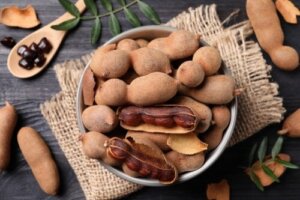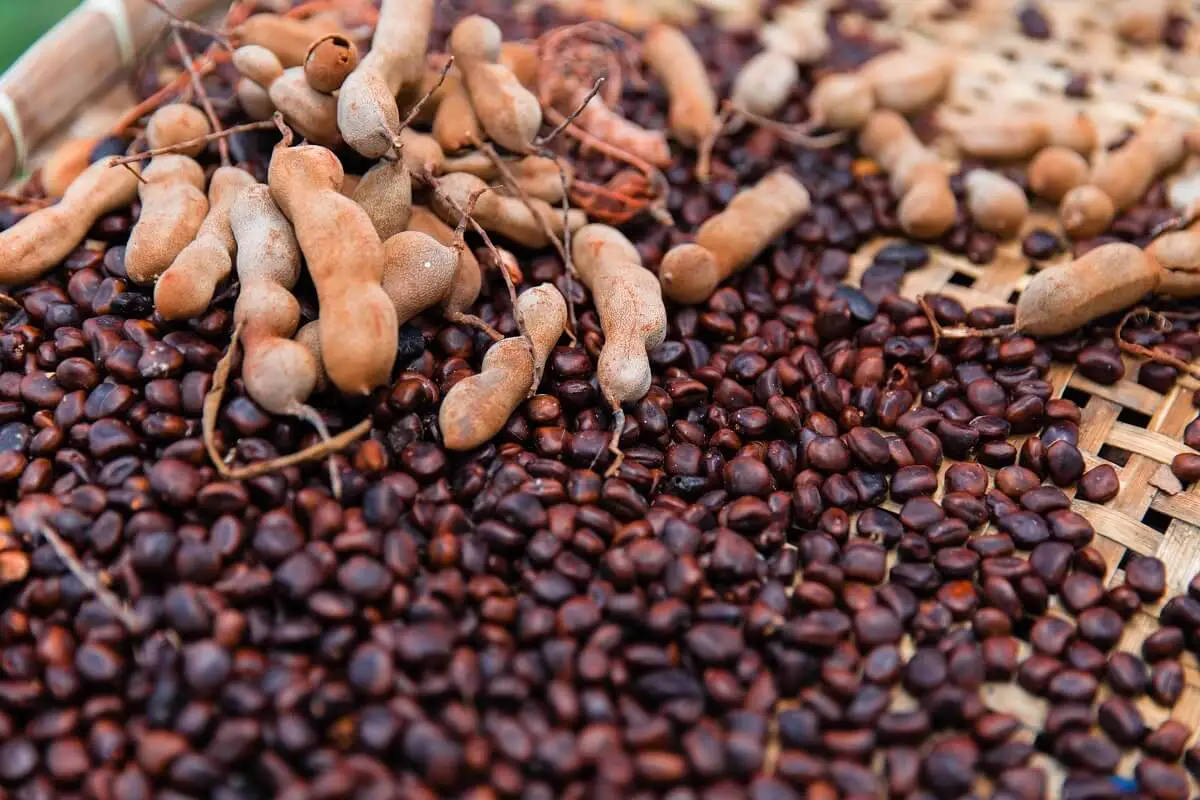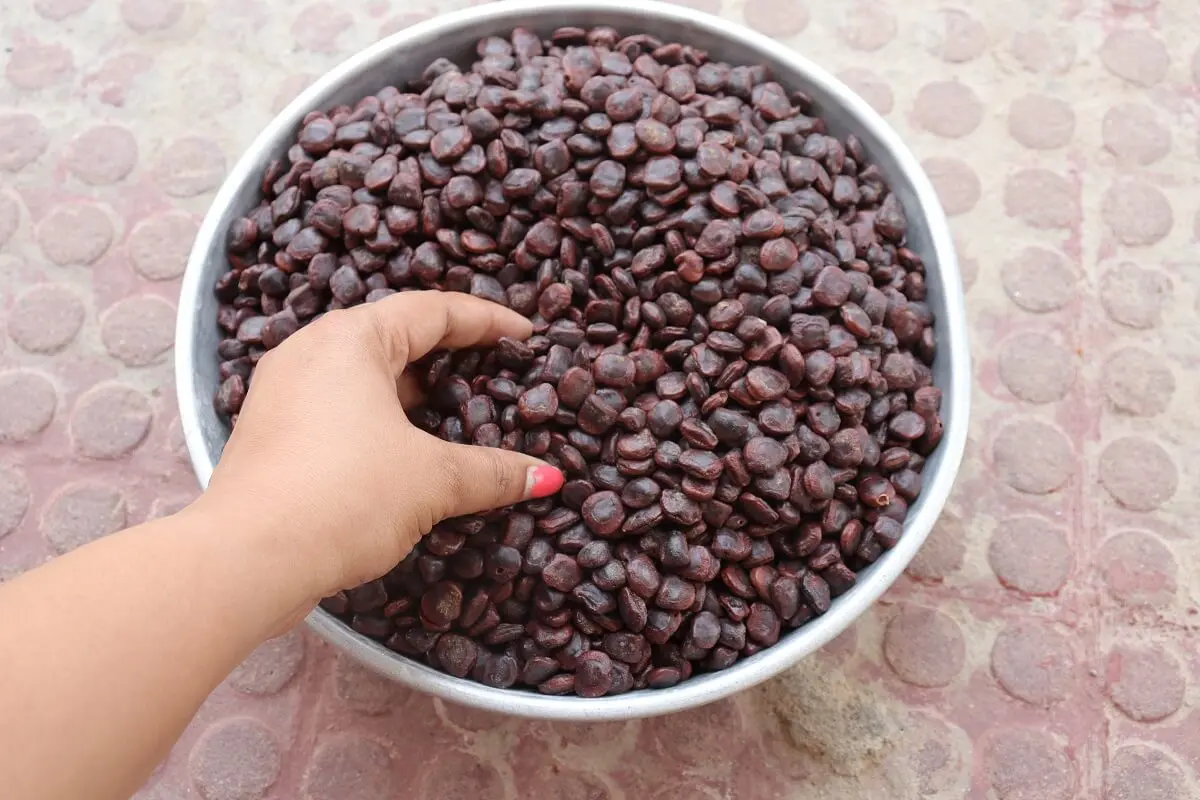Tamarind Seeds: A Healthy Snack for Your Diet


Written and verified by the nutritionist Maria Patricia Pinero Corredor
Tamarind seeds have been used in different ways since ancient times due to their nutritional properties. They come from the plant with the scientific name Tamarindo indica, one of the few leguminous species of which all its parts are used.
However little has been reported on their bioactive compounds and their health benefits. Evidence suggests that they’re useful for regulating cholesterol, reducing blood glucose levels, and combating constipation. Do you know other uses for this healthy snack?
What are tamarind seeds?
The tamarind tree is considered native to India and belongs to the Fabaceae family, i.e. legumes. The most used part in gastronomy is the fruit, which is found inside a shell known as a pod. Its brown pulp has a sweet and sour taste and covers several seeds.
The latter represent 33% of the entire fruit. They have a very hard shell covering the white endosperm, which is the soft, edible part. They are considered a by-product with several health benefits. They’re a source of antioxidants, vitamins, minerals, and protein.

Read more: Ways to Use Tamarind in Your Recipes
Composition of tamarind seeds
Tamarind seeds contain a mixture of nutrients and bioactive compounds that make them a healthy addition to your diet. Let’s see what their main components are.
Pectins
They contain a type of carbohydrate called “pectins”. This is a form of soluble fiber that, when mixed with water, acts as a thickener and forms a gelatinous substance.
Protein and fiber
El-Siddig and other experts reveal that tamarind seeds contain 23 grams of protein per 100 grams (1 oz per 4 oz approx.) Thus, when consumed as a snack, they help to cover the daily requirements of this macronutrient in adults.
On the other hand, fiber is 20%, concentrated mainly in the outer part of the seed. These high values contribute to maintaining gastrointestinal health.
Amino acid profile
The proteins of these seeds contain a good balance of amino acids. Professor El-Siddig reports that of the 8 essential amino acids, 3 of them cover more than 100% of the requirements.
However, four others are very close to what is required. Only tryptophan, like other seeds, covers only 25%.
Fats
The value of fats ranges between 3 and 11 %. More than half is of the polyunsaturated type. Within them, linoleic fatty acid – which is essential for nutrition – is the main type. In addition, when balanced with omega-3s, they benefit cardiovascular health.
Minerals
Ajayi and Joseph, who have studied tamarind seeds, consider them to be a good source of several mineral elements. Among them are potassium and copper, which are found in the highest concentration.
Calcium also stands out, whose values are as high as in cereals. Other important minerals in these seeds are magnesium, phosphorus, and zinc.
Bioactive compounds
Tamarind seeds have high values of phenolic compounds that demonstrate high antioxidant activity, such as epicatechin and dihydroxyacetophenone.
In fact, its extract exhibits a strong capacity to reduce lipid peroxidation in vitro. These phenols protect linoleic fatty acid. In turn, they demonstrate higher antioxidant activity when compared to vitamin C and other synthetic additives.
Dr. Siddhuraju explains that the presence of these antioxidants benefits health, as they’re able to prevent oxidative damage at a cellular level. Phenols fight free radicals, which are associated with certain disorders such as atherosclerosis and premature aging. They may even prevent cancer.
Anti-nutritional factors
Not surprisingly, tamarind seeds contain high proportions of so-called anti-nutritional factors (ANF), which are present in other legumes and cereals.
These include tannins, which give the seed its astringent and bitter characteristic when eaten raw. These are more concentrated in the brown outer coating, but the edible part still contains them. Therefore, it’s recommended to boil or roast them to eliminate part of the tannins.
Another anti-nutritional factor is phytic acid, which can trap some minerals and prevent their absorption. Fortunately, it’s removed by soaking and cooking. Lectin and trypsin inhibitor are known HABs because they bind to proteins, including those involved in digestion.
Benefits of tamarind seeds
The presence of bioactive compounds and nutrients gives it its characteristic as a beneficial food ingredient for health. Here are its possible effects.
Helps regulate metabolic processes
Research suggests that tamarind seeds can regulate certain metabolic processes in animals. The test resulted in a decrease in cholesterol and blood sugar by feeding tamarind seeds to a group of rats for 1 month.
Despite these findings, more studies are needed to prove the effect in humans.
Antiviral activity
A study in India revealed that this ingredient has antiviral properties. In particular, it was observed that the anti-nutritional factor lectin causes the virus to lose 64% of its effectiveness. In addition, it reduces viral RNA levels in cells by 45%.
Moreover, another study has recognized the antiviral potential of these seeds in the treatment of Covid-19 in obese patients. According to the authors, it has been found that the trypsin inhibitor in tamarind can reduce certain inflammatory markers. Likewise, it o annul can annul the activity of neutrophils, characteristic of the pulmonary lesion promoted by the virus.
Helps with digestive health
The presence of soluble fiber in tamarind seeds favors the digestive process, improves constipation, and prevents the formation of flatulence that is characteristic of other legumes. This nutrient is also able to reduce cholesterol and slows down the absorption of sugar from food.
Can be used as a protein supplement
The high protein values in these seeds can be used as a dietary supplement. A good way to do this is to use them as a mid-morning or mid-afternoon snack.
How to prepare tamarind seeds
You may be wondering how to prepare tamarind seeds if they have such a hard coating. Don’t worry! We’ll explain all.
1. As toasted seeds
In a frying pan, place the tamarind seeds and cook them over a medium heat. Stir constantly, between 8 and 10 minutes. Then, remove them from heat and let them stand. Finally, remove the peel and consume them.
Another option is to boil them to make them a little softer. They can replace nuts as a snack, with the advantage of containing fewer calories.

2. In flour form
Once you remove the coating, you can put them the oven to dry them at about 120 degrees Celsius (250 F). You must be careful to stir them so they don’t burn.
After about 45 minutes, remove them, let them cool, and put them in the food processor to prepare the flour. If, on taking them out of the oven, you still see that they’re still wet, dry them for a little longer.
Tamarind flour can be added to wheat flour, corn flour or any other flour to provide more protein and minerals. You should know that this flour is ideal for those who suffer from gluten intolerance or sensitivity, since it doesn’t contain gluten.
How much should you eat?
The high fiber and protein content of these seeds promotes satiety. One ounce will provide 7 grams of protein, sources of essential amino acids. In addition, it has about 6 grams of soluble fiber, which will help you stay healthy. You can double this intake by consuming 2 snacks a day.
In short, this food is an excellent snack that you can include in your diet. However, if you suffer from any chronic pathologies, don’t forget to consult a nutrition professional to establish the appropriate amounts.
All cited sources were thoroughly reviewed by our team to ensure their quality, reliability, currency, and validity. The bibliography of this article was considered reliable and of academic or scientific accuracy.
- De Caluwé, E. & Halamová, K. & Van Damme, P., (2010) “Tamarindus indica L. – Una revisión de usos tradicionales, fitoquímica y farmacología”, Afrika Focus 23(1). doi: https://doi.org/10.21825/af.v23i1.5039
- El-Siddig, K., Gunasena, H.P.M., Prasa, B.A., Pushpakumara, D.K.N.G., Ramana, K.V.R., Vijayanand. P., Williams, J.T. (2006). Tamarind – Tamarindus indica L. Fruits for the future 1. Southampton Centre for Underutilized Crops, Southampton, UK, 188p. Disponible en: https://www.cambridge.org/core/journals/experimental-agriculture/article/abs/fruits-for-the-future-1-revised-edition-tamarind-tamarindus-indica-l-by-k-elsiddeg-h-p-m-gunesana-b-a-prasad-d-k-n-g-pushpukumara-k-v-r-ramana-p-vijayananand-and-j-t-williams-southampton-uk-southampton-centre-for-underutilized-crops-2006-pp-188-available-free-on-request-to-national-scientists-of-developing-countries-isbn-854328599/43A1FA8CC8872E48C8AAD3356C48DEB0
- Julio Sanhueza Catalán , Samuel Durán Agüero y Jairo Torres García. Los ácidos grasos dietarios y su relación con la salud. Nutr Hosp. 2015;32(3):1362-1375. Disponible en: http://www.aulamedica.es/nh/pdf/9276.pdf
- Ajayi, I.A., Oderinde, R.A., Kajogbola, D.O., & Uponi, J.I. (2006). Oil content and fatty acid composition of some underutilized legumes from Nigeria. Food Chemistry, 99, 115-120. Disponible en: https://www.semanticscholar.org/paper/Oil-content-and-fatty-acid-composition-of-some-from-Ajayi-Oderinde/c2e6e3f3f93e64e117009c79c7bdcb2bc2ced2d8
- Soong, Y.Y., & Barlow, P.J. (2004). Antioxidant activity and phenolic content of selected fruit seeds. Food Chemistry, 88, 411-417. Disponible en: https://www.semanticscholar.org/paper/Antioxidant-activity-and-phenolic-content-of-fruit-Soong-Barlow/7bc5d366f9e957c2534ecc85b1a8989e17bfd392
- Siddhuraju, P. (2007). Antioxidant activity of polyphenolic compounds extracted from defatted raw and dry heated Tamarindus indica seed coat. Lwt – Food Science and Technology, 40, 982-990. Disponible en: https://www.semanticscholar.org/paper/Antioxidant-activity-of-polyphenolic-compounds-from-Siddhuraju/f49894af518f862b3b6156e790332dc4d16b0374
- Uzukwu Emmanuel Uchenna, Amal Bakr Shori, Ahmad Salihin Baba. Tamarindus indica seeds improve carbohydrate and lipid metabolism: An in vivo study. Journal of Ayurveda and Integrative Medicine. Volume 9, Issue 4, October–December 2018, Pages 258-265. Disponible en: https://www.sciencedirect.com/science/article/pii/S0975947616305083?via=ihub
- Manash Pratim Gohain. Tamarind seeds has antiviral properties and can potentially. 2018, Read more at:
http://timesofindia.indiatimes.com/articleshow/66614928.cms?utm_source=contentofinterest&utm_medium=text&utm_campaign=cppst - Morais, A., de Medeiros, A. F., Medeiros, I., de Lima, V., Luz, A., Maciel, B., & Passos, T. S. (2021). Tamarind (Tamarindus indica L.) Seed a Candidate Protein Source with Potential for Combating SARS-CoV-2 Infection in Obesity. Drug target insights, 15, 5–12. https://doi.org/10.33393/dti.2021.2192
This text is provided for informational purposes only and does not replace consultation with a professional. If in doubt, consult your specialist.








